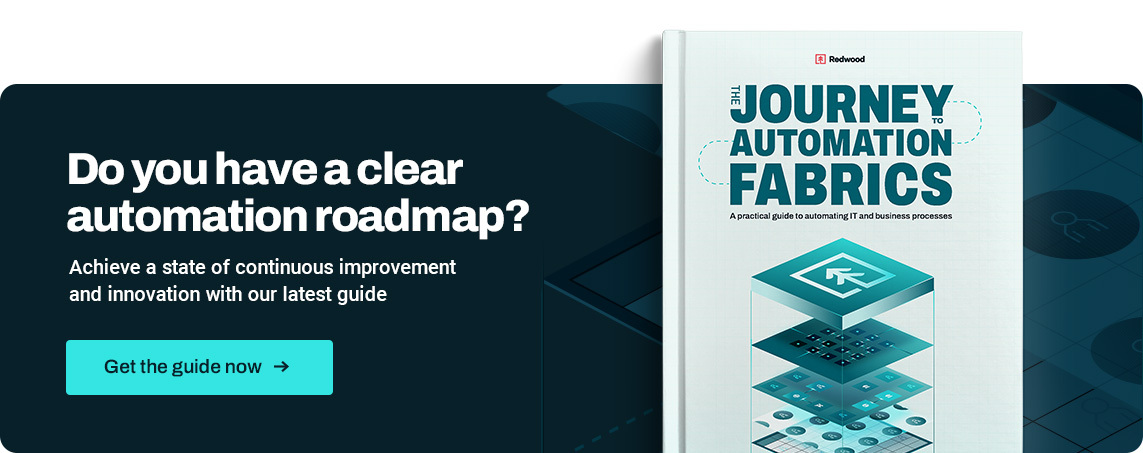Best practices for an automation Center of Excellence

As automation has become more achievable over the past two to three decades, most businesses have adopted ad-hoc automation solutions. Now, there’s a shift underway towards a more cohesive, enterprise-wide approach to automation. This requires more than just the right resources and technology to make it successful — it demands a dedicated team to coordinate, manage and scale these efforts.
An automation Center of Excellence (CoE) can serve as the hub for all automation activities across your organization, bringing structure, expertise and alignment. Regardless of the size of your organization, a CoE can help you use the resources you have to their fullest potential.
Here’s how to use your automation CoE to stay focused on a big-picture strategy that will drive your organization confidently into the future.
Why a Center of Excellence matters for automation
A CoE can enable you to move beyond disparate, siloed automation. Properly set up, it can:
- Centralize knowledge strategy and governance to make onboarding and training easier while reducing redundancy.
- Establish clear objectives and metrics to align automation projects with business goals and help generate measurable results.
- Drive consistency and scalability, so you apply the same standards and best practices across your business.
Most importantly, this team makes your automation initiatives technology-agnostic, so you’re not hopping from one angle to the next based on which systems or tools you happen to have in place.
Best practice #1: Develop a clear vision
What it does: Aligns your automation initiatives with overall business objectives
The CoE must start with a vision that will guide its activities and gain buy-in. The first step is to create a roadmap that includes:
- Short-term wins: Quick-win automation projects that deliver immediate ROI to build momentum and show tangible benefits
- Long-term transformation: A plan for strategic, large-scale automation projects that can transform core processes over time to support business resilience
You should also identify and assign key roles and responsibilities. Who will be your:
- Key decision-makers: Individuals who approve automation projects and ensure alignment with business objectives?
- Automation champions: Leaders who advocate for automation and inspire teams to adopt new tools and processes?
- Subject matter experts (SMEs): Experts in various departments who can help identify automation opportunities, provide insights on current processes and assist in implementing new solutions?
Finally, no vision is complete without the practical parts. In this case, those include documentation, governance and auditing. Decide how you’ll maintain thorough documentation for each automation that covers workflows, dependencies and regulatory requirements. It’s important to create guidelines around design, deployment and monitoring , and you’ll want to audit each automation regularly.
Tips for the first stage of setting up your CoE:
- Create a CoE charter that outlines objectives, responsibilities and guidelines.
- Designate a leader responsible for executing the vision and managing the team.
- Set up an automation review board to evaluate and approve new initiatives.
Best practice #2: Build a cross-functional team
What it does: Ensures diverse perspectives and buy-in
It’s essential to include representatives from various business units in your Coe to align your automation goals with the unique needs of each department. Each team member brings firsthand insights into everyday pain points and can help the CoE understand where automation can make the most impact. Consider roles for people in IT, Operations, Finance, HR and more.
Tips for building an effective team:
- Conduct regular meetings and workshops.
- Kick off your CoE with pilot projects to test cross-team efforts.
- Leverage collaborative tools to maintain visibility.

Best practice #3: Prioritize training and upskilling
What it does: Increases team competency and confidence
A CoE’s success relies on a well-trained team that’s confident and capable of executing advanced automation initiatives. Adequate training and upskilling allow individual team members to explore new technologies and further improve processes.
Remember that training doesn’t just mean technical help with using automation technology; it means helping your team develop a deeper understanding of automation’s potential impact and helping them think critically about how to use it responsibly.
Tips for training and upskilling:
- Enroll CoE members in certification programs offered by your software providers.
- Create an internal drive or portal for easy access to resources.
- Pair seasoned automation experts with less experienced team members.
Best practice #4: Standardize processes and metrics
What it does: Facilitates easy and consistent automation adoption across your organization
Your CoE should have a framework for adopting automation from planning to execution. This will reduce barriers and make it easier to transition processes from manual to automated.
It’s also helpful to determine performance metrics from the start — cost savings, time reduction, error rates, etc.
Tips for standardization:
- Create a library of standardized templates and workflows — or use a platform that has them built in.
- Automate reporting and share performance metrics regularly.
- Conduct quarterly audits of processes to maintain quality.
Best practice #5: Implement scalable solutions
What it does: Demonstrates value quickly
Begin with high-impact, low-complexity automations to increase time-to-value. Start with things that help you achieve better data accuracy, faster processing times or other day-to-day efficiency-boosting KPIs. Examples include report generation or data transfer.
If you have a small to mid-sized organization, this might mean creating a lean CoE that can scale gradually and using tools with out-of-the-box integrations.
Tips for scalability:
- Achieve quick wins with straightforward automations and use them as proof of concept for larger projects.
- Set up feedback loops with users after each automation deployment.
- Replicate successful automations in other departments.

An automation CoE is a vital piece of your automation strategy, especially as your organization grows and your needs mature.
You’ll be able to tell how well you’ve implemented all of the above based on the scope of your automated processes, the depth of those processes and whether your organizational setup is helping or hindering your automation rollouts.
Take our free, five-minute assessment to determine your stage of automation and pinpoint the perfect time to launch or refine your automation CoE.
About The Author

Devin Gharibian-Saki
Devin Gharibian-Saki brings a wealth of knowledge and expertise on enterprise IT, the SAP ecosystem and business process automation to his current role as SVP of Business Development and Strategy at Redwood Software. Experience within product marketing, product management and enterprise software sales enables Devin to drive strategic initiatives and alliances for the organization and unlock new business models and go-to-market strategies. Acting as an executive advocate for the customer, Devin is passionate about delivering the best solutions to make the most out of a customer’s environment. His approach centers on connecting with customers, prospects and partners to better understand how Redwood can help their digital transformation initiatives, improving their automation roadmaps by leveraging a combination of his SAP and process optimization proficiencies.
Prior to working for Redwood, Devin was an SAP Technology Consultant, working directly at SAP and at EnBW, the third-largest utility in Germany. Devin holds a diploma in Mathematics from Karlsruhe Institute of Technology in Karlsruhe, Germany, as well as two patents.